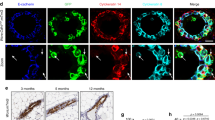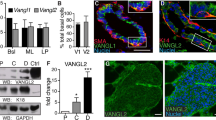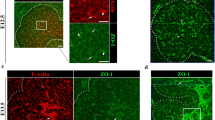Abstract
The extracellular matrix has a crucial role in determining the spatial orientation of epithelial polarity and the formation of lumens in glandular tissues; however, the underlying mechanisms remain elusive. By using Cre–Lox deletion we show that β1 integrins are required for normal mammary gland morphogenesis and lumen formation, both in vivo and in a three-dimensional primary culture model in which epithelial cells directly contact a basement membrane. Downstream of basement membrane β1 integrins, Rac1 is not involved; however, ILK is needed to polarize microtubule plus ends at the basolateral membrane and disrupting each of these components prevents lumen formation. The integrin–microtubule axis is necessary for the endocytic removal of apical proteins from the basement-membrane–cell interface and for internal Golgi positioning. We propose that this integrin signalling network controls the delivery of apical components to the correct surface and thereby governs the orientation of polarity and development of lumens.
This is a preview of subscription content, access via your institution
Access options
Subscribe to this journal
Receive 12 print issues and online access
$209.00 per year
only $17.42 per issue
Buy this article
- Purchase on Springer Link
- Instant access to full article PDF
Prices may be subject to local taxes which are calculated during checkout








Similar content being viewed by others
References
Carmosino, M., Valenti, G., Caplan, M. & Svelto, M. Polarized traffic towards the cell surface: how to find the route. Biol. Cell 102, 75–91 (2009).
Assemat, E., Bazellieres, E., Pallesi-Pocachard, E., Le Bivic, A. & Massey-Harroche, D. Polarity complex proteins. Biochim. Biophys. Acta 1778, 614–630 (2008).
Musch, A. Microtubule organization and function in epithelial cells. Traffic 5, 1–9 (2004).
Rodriguez-Boulan, E., Kreitzer, G. & Musch, A. Organization of vesicular trafficking in epithelia. Nat. Rev. Mol. Cell Biol. 6, 233–247 (2005).
Ojakian, G. K. & Schwimmer, R. Regulation of epithelial cell surface polarity reversal by β1 integrins. J. Cell Sci. 107, 561–576 (1994).
Wang, A. Z., Ojakian, G. K. & Nelson, W. J. Steps in the morphogenesis of a polarized epithelium. I. Uncoupling the roles of cell–cell and cell–substratum contact in establishing plasma membrane polarity in multicellular epithelial (MDCK) cysts. J. Cell Sci. 95, 137–151 (1990).
Wang, A. Z., Ojakian, G. K. & Nelson, W. J. Steps in the morphogenesis of a polarized epithelium. II. Disassembly and assembly of plasma membrane domains during reversal of epithelial cell polarity in multicellular epithelial (MDCK) cysts. J. Cell Sci. 95, 153–165 (1990).
Zaidel-Bar, R., Itzkovitz, S., Ma’ayan, A., Iyengar, R. & Geiger, B. Functional atlas of the integrin adhesome. Nat. Cell Biol. 9, 858–867 (2007).
Streuli, C. H. & Akhtar, N. Signal co-operation between integrins and other receptor systems. Biochem. J. 418, 491–506 (2009).
Zovein, A. C. et al. β1 integrin establishes endothelial cell polarity andarteriolar lumen formation via a Par3-dependent mechanism. Dev. Cell 18, 39–51 (2010).
Lechler, T. & Fuchs, E. Asymmetric cell divisions promote stratification and differentiation of mammalian skin. Nature 437, 275–280 (2005).
Yu, W. et al. β1-integrin orients epithelial polarity via Rac1 and laminin. Mol. Biol. Cell 16, 433–445 (2005).
Naylor, M. J. et al. Ablation of β1 integrin in mammary epithelium reveals a key role for integrin in glandular morphogenesis and differentiation. J. Cell Biol. 171, 717–728 (2005).
O’Brien, L. E. et al. Rac1 orientates epithelial apical polarity through effects on basolateral laminin assembly. Nat. Cell Biol. 3, 831–838 (2001).
Cohen, D., Fernandez, D., Lazaro-Dieguez, F. & Musch, A. The serine/threonine kinase Par1b regulates epithelial lumen polarity via IRSp53-mediated cell–ECM signaling. J. Cell Biol. 192, 525–540 (2011).
Jeanes, A. I. et al. Specific β-containing integrins exert differential control on proliferation and two-dimensional collective cell migration in mammary epithelial cells. J. Biol. Chem. 287, 24103–24112.
Akhtar, N. et al. Molecular dissection of integrin signalling proteins in the control of mammary epithelial development and differentiation. Development 136, 1019–1027 (2009).
Debnath, J. & Brugge, J. S. Modelling glandular epithelial cancers in three-dimensional cultures. Nat. Rev. Cancer 5, 675–688 (2005).
Jaffe, A. B., Kaji, N., Durgan, J. & Hall, A. Cdc42 controls spindle orientation to position the apical surface during epithelial morphogenesis. J. Cell Biol. 183, 625–633 (2008).
Jechlinger, M., Podsypanina, K. & Varmus, H. Regulation of transgenes in three-dimensional cultures of primary mouse mammary cells demonstrates oncogene dependence and identifies cells that survive deinduction. Genes Dev. 23, 1677–1688 (2009).
Qin, Y., Meisen, W. H., Hao, Y. & Macara, I. G. Tuba, a Cdc42 GEF, is required for polarized spindle orientation during epithelial cyst formation. J. Cell Biol. 189, 661–669 (2010).
Pearson, J. F., Hughes, S., Chambers, K. & Lang, S. H. Polarized fluid movement and not cell death, creates luminal spaces in adult prostate epithelium. Cell Death Differ. 16, 475–482 (2009).
Brakebusch, C. et al. Skin and hair follicle integrity is crucially dependent on β1 integrin expression on keratinocytes. EMBO J. 19, 3990–4003 (2000).
Martin-Belmonte, F. & Mostov, K. Regulation of cell polarity during epithelial morphogenesis. Curr. Opin. Cell Biol. 20, 227–234 (2008).
Klinowska, T. C. et al. Epithelial development and differentiation in the mammary gland is not dependent on α3 or α6 integrin subunits. Dev. Biol. 233, 449–467 (2001).
Yadav, S., Puri, S. & Linstedt, A. D. A primary role for Golgi positioning in directed secretion, cell polarity, and wound healing. Mol. Biol. Cell 20, 1728–1736 (2009).
Allan, V. J., Thompson, H. M. & McNiven, M. A. Motoring around the Golgi. Nat. Cell Biol. 4, E236–E242 (2002).
Humphries, J. D. et al. Proteomic analysis of integrin-associated complexes identifies RCC2 as a dual regulator of Rac1 and Arf6. Sci. Signal. 2, ra51 (2009).
Fielding, A. B., Dobreva, I., McDonald, P. C., Foster, L. J. & Dedhar, S. Integrin-linked kinase localizes to the centrosome and regulates mitotic spindle organization. J. Cell Biol. 180, 681–689 (2008).
Wickstrom, S. A. et al. Integrin-linked kinase controls microtubule dynamics required for plasma membrane targeting of caveolae. Dev. Cell 19, 574–588 (2010).
Jaulin, F. & Kreitzer, G. KIF17 stabilizes microtubules and contributes to epithelial morphogenesis by acting at MT plus ends with EB1 and APC. J. Cell Biol. 190, 443–460.
Bacallao, R. et al. The subcellular organization of Madin-Darby canine kidney cells during the formation of a polarized epithelium. J. Cell Biol. 109, 2817–2832 (1989).
Bre, M. H. et al. Regulation of microtubule dynamics and nucleation during polarization in MDCK II cells. J. Cell Biol. 111, 3013–3021 (1990).
Marchiando, A. M. et al. Caveolin-1-dependent occludin endocytosis is required for TNF-induced tight junction regulation in vivo. J. Cell Biol. 189, 111–126 (2010).
Stamatovic, S. M., Keep, R. F., Wang, M. M., Jankovic, I. & Andjelkovic, A. V. Caveolae-mediated internalization of occludin and claudin-5 during CCL2-induced tight junction remodeling in brain endothelial cells. J. Biol. Chem. 284, 19053–19066 (2009).
Singh, R. D. et al. Inhibition of caveolar uptake, SV40 infection, and β1-integrin signaling by a nonnatural glycosphingolipid stereoisomer. J. Cell Biol. 176, 895–901 (2007).
Bryant, D. M. et al. A molecular network for de novo generation of the apical surface and lumen. Nat. Cell Biol. 12, 1035–1045 (2010).
Schluter, M. A. et al. Trafficking of Crumbs3 during cytokinesis is crucial for lumen formation. Mol. Biol. Cell 20, 4652–4663 (2009).
Walmsley, M. J. et al. Critical roles for Rac1 and Rac2 GTPases in B cell development and signaling. Science 302, 459–462 (2003).
Terpstra, L. et al. Reduced chondrocyte proliferation and chondrodysplasia in mice lacking the integrin-linked kinase in chondrocytes. J. Cell Biol. 162, 139–148 (2003).
Danielian, P. S., Muccino, D., Rowitch, D. H., Michael, S. K. & McMahon, A. P. Modification of gene activity in mouse embryos in utero by a tamoxifen-inducible form of Cre recombinase. Curr. Biol. 8, 1323–1326 (1998).
Pullan, S. et al. Requirement of basement membrane for the suppressionof programmed cell death in mammary epithelium. J. Cell Sci. 109, 631–642 (1996).
Streuli, C. H. et al. Laminin mediates tissue-specific gene expression in mammary epithelia. J. Cell Biol. 129, 591–603 (1995).
Akhtar, N. & Streuli, C. H. Rac1 links integrin-mediated adhesion to the controlof lactational differentiation in mammary epithelia. J. Cell Biol. 173, 781–793 (2006).
Altschuler, Y. et al. Redundant and distinct functions for dynamin-1 and dynamin-2 isoforms. J. Cell Biol. 143, 1871–1881 (1998).
Ceresa, B. P., Lotscher, M. & Schmid, S. L. Receptor and membrane recycling can occur with unaltered efficiency despite dramatic Rab5(q79l)-induced changes in endosome geometry. J. Biol. Chem. 276, 9649–9654 (2001).
Komarova, Y. et al. EB1 and EB3 control CLIP dissociation from the ends of growing microtubules. Mol. Biol. Cell 16, 5334–5345 (2005).
Wang, P., Ballestrem, C. & Streuli, C. H. The C terminus of talin links integrins to cell cycle progression. J. Cell Biol. 195, 499–513.
Payne, C. M. & Satterfield, V. F. A simple procedure for the preparation of rosetted cells for electron microscopy. J. Clin. Pathol. 33, 505–508 (1980).
Valentijn, A. J., Metcalfe, A. D., Kott, J., Streuli, C. H. & Gilmore, A. P. Spatial and temporal changes in Bax subcellular localization during anoikis. J. Cell Biol. 162, 599–612 (2003).
Nishimura, N. & Sasaki, T. Cell-surface biotinylation to study endocytosis and recycling of occludin. Methods Mol. Biol. 440, 89–96 (2008).
Acknowledgements
We thank C. Jones for doing the electron microscopy, S. Schmid (Scripps Research Institute, La Jolla, USA) and B. Ceresa (University of Louisville, USA) for dynamin and Rab5a adenoviruses, C. Wu (University of Pittsburgh, USA) for anti-ILK monoclonal, M. Lowe (University of Manchester, UK) for GM130 polyclonal and P. March for confocal microscope training. The FLS Bioimaging Facility microscopes were purchased with grants from the BBSRC, Wellcome and the University of Manchester Strategic Fund. Thanks to P. Caswell, T. Hardingham, M. Humphries, M. Lowe, N. Papalopulu and P. Lu and for critical appraisal of the manuscript. This work was supported by the Wellcome Trust (no. 081203/Z/06/Z). The Wellcome Trust Centre for Cell-Matrix Research is supported by core funding from the Wellcome Trust (no. 088785/Z/09/Z).
Author information
Authors and Affiliations
Contributions
N.A. conceived ideas, performed experiments, analysed and interpreted the data and wrote the manuscript. C.H.S. conceived ideas and wrote the manuscript.
Corresponding authors
Ethics declarations
Competing interests
The authors declare no competing financial interests.
Supplementary information
Supplementary Information
Supplementary Information (PDF 1519 kb)
Supplementary Table 1
Supplementary Information (XLS 30 kb)
Wildtype MEC acinar on BMM rendered in 3D.
A third was removed to show an apical lumen (aPKC; red) and basolateral surface (β1 integrin; green). (MOV 11467 kb)
β1 integrin deleted MEC acinar on BMM rendered in 3D
A third was removed to show filled lumen. Note apical polarity (aPKC; red) inversion to outer membrane and a loss of β1 integrin (green). (MOV 9060 kb)
Rights and permissions
About this article
Cite this article
Akhtar, N., Streuli, C. An integrin–ILK–microtubule network orients cell polarity and lumen formation in glandular epithelium. Nat Cell Biol 15, 17–27 (2013). https://doi.org/10.1038/ncb2646
Received:
Accepted:
Published:
Issue Date:
DOI: https://doi.org/10.1038/ncb2646
This article is cited by
-
Annexin A1 is a polarity cue that directs mitotic spindle orientation during mammalian epithelial morphogenesis
Nature Communications (2023)
-
Apical–basal polarity and the control of epithelial form and function
Nature Reviews Molecular Cell Biology (2022)
-
High-throughput formation and image-based analysis of basal-in mammary organoids in 384-well plates
Scientific Reports (2022)
-
Extrahepatic cholangiocyte obstruction is mediated by decreased glutathione, Wnt and Notch signaling pathways in a toxic model of biliary atresia
Scientific Reports (2020)
-
Biomimetic niches reveal the minimal cues to trigger apical lumen formation in single hepatocytes
Nature Materials (2020)



